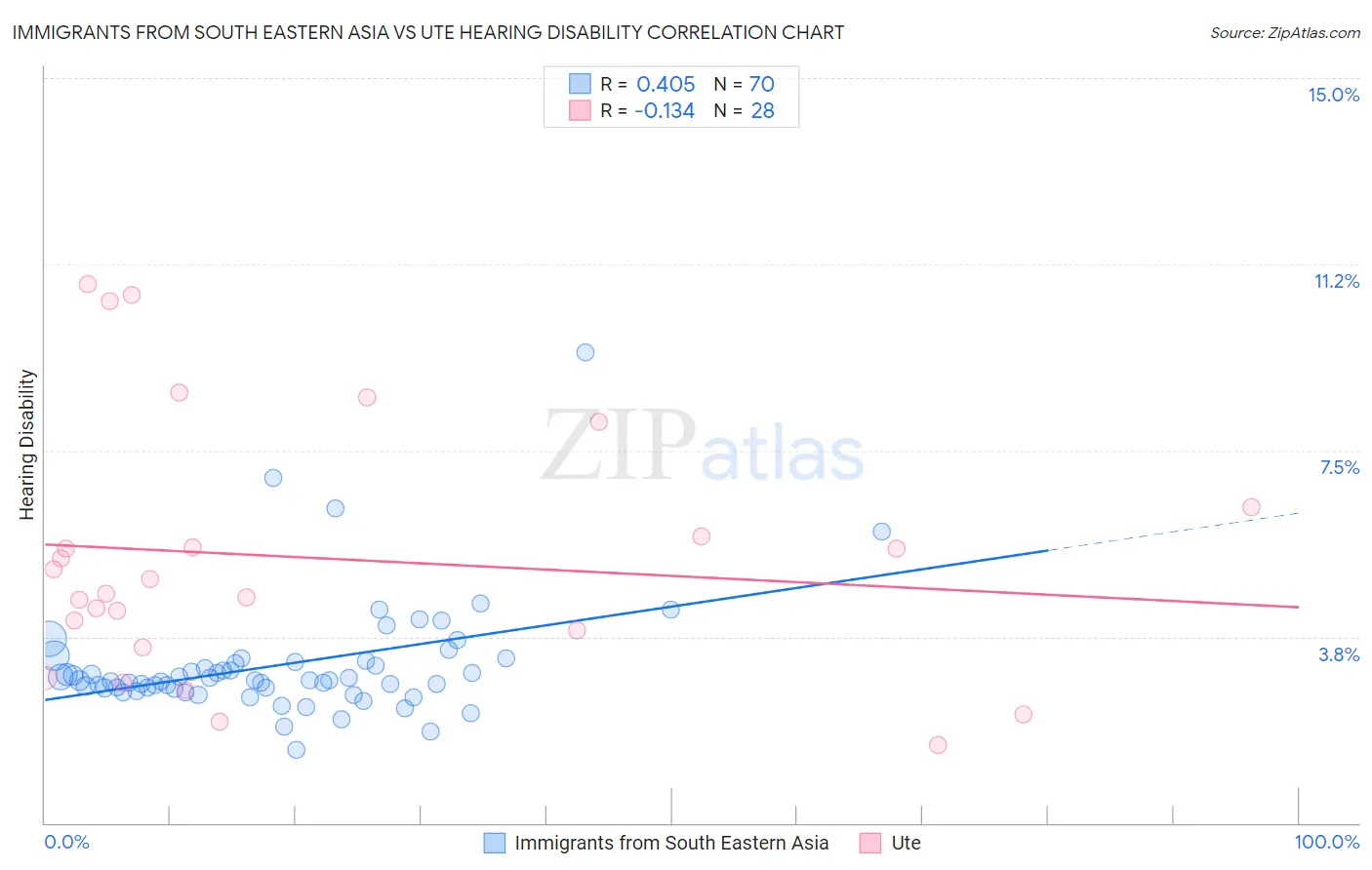Immigrants from South Eastern Asia vs Ute Hearing Disability
COMPARE
Immigrants from South Eastern Asia
Ute
Hearing Disability
Hearing Disability Comparison
Immigrants from South Eastern Asia
Ute
3.0%
HEARING DISABILITY
62.9/ 100
METRIC RATING
166th/ 347
METRIC RANK
3.5%
HEARING DISABILITY
0.1/ 100
METRIC RATING
269th/ 347
METRIC RANK
Immigrants from South Eastern Asia vs Ute Hearing Disability Correlation Chart
The statistical analysis conducted on geographies consisting of 512,290,375 people shows a moderate positive correlation between the proportion of Immigrants from South Eastern Asia and percentage of population with hearing disability in the United States with a correlation coefficient (R) of 0.405 and weighted average of 3.0%. Similarly, the statistical analysis conducted on geographies consisting of 55,656,713 people shows a poor negative correlation between the proportion of Ute and percentage of population with hearing disability in the United States with a correlation coefficient (R) of -0.134 and weighted average of 3.5%, a difference of 18.3%.

Hearing Disability Correlation Summary
| Measurement | Immigrants from South Eastern Asia | Ute |
| Minimum | 1.5% | 1.6% |
| Maximum | 9.5% | 10.9% |
| Range | 8.0% | 9.3% |
| Mean | 3.2% | 5.3% |
| Median | 2.9% | 4.8% |
| Interquartile 25% (IQ1) | 2.7% | 3.7% |
| Interquartile 75% (IQ3) | 3.2% | 6.1% |
| Interquartile Range (IQR) | 0.53% | 2.3% |
| Standard Deviation (Sample) | 1.2% | 2.6% |
| Standard Deviation (Population) | 1.2% | 2.5% |
Similar Demographics by Hearing Disability
Demographics Similar to Immigrants from South Eastern Asia by Hearing Disability
In terms of hearing disability, the demographic groups most similar to Immigrants from South Eastern Asia are Immigrants from Zimbabwe (3.0%, a difference of 0.14%), Immigrants from Cambodia (3.0%, a difference of 0.20%), Immigrants from Central America (3.0%, a difference of 0.21%), Immigrants from Japan (2.9%, a difference of 0.36%), and Albanian (2.9%, a difference of 0.39%).
| Demographics | Rating | Rank | Hearing Disability |
| Immigrants | Australia | 67.4 /100 | #159 | Good 2.9% |
| Immigrants | Fiji | 67.1 /100 | #160 | Good 2.9% |
| Albanians | 66.6 /100 | #161 | Good 2.9% |
| Immigrants | Japan | 66.3 /100 | #162 | Good 2.9% |
| Immigrants | Central America | 64.9 /100 | #163 | Good 3.0% |
| Immigrants | Cambodia | 64.8 /100 | #164 | Good 3.0% |
| Immigrants | Zimbabwe | 64.2 /100 | #165 | Good 3.0% |
| Immigrants | South Eastern Asia | 62.9 /100 | #166 | Good 3.0% |
| Immigrants | Eastern Europe | 58.1 /100 | #167 | Average 3.0% |
| Immigrants | Greece | 57.9 /100 | #168 | Average 3.0% |
| Arabs | 57.6 /100 | #169 | Average 3.0% |
| Immigrants | Cabo Verde | 56.9 /100 | #170 | Average 3.0% |
| Immigrants | Ukraine | 56.6 /100 | #171 | Average 3.0% |
| Armenians | 56.0 /100 | #172 | Average 3.0% |
| Immigrants | Serbia | 51.1 /100 | #173 | Average 3.0% |
Demographics Similar to Ute by Hearing Disability
In terms of hearing disability, the demographic groups most similar to Ute are Spaniard (3.5%, a difference of 0.30%), Canadian (3.5%, a difference of 0.32%), European (3.5%, a difference of 0.35%), Belgian (3.5%, a difference of 0.54%), and Czech (3.5%, a difference of 0.61%).
| Demographics | Rating | Rank | Hearing Disability |
| Immigrants | North America | 0.1 /100 | #262 | Tragic 3.5% |
| Immigrants | Canada | 0.1 /100 | #263 | Tragic 3.5% |
| Immigrants | Germany | 0.1 /100 | #264 | Tragic 3.5% |
| British | 0.1 /100 | #265 | Tragic 3.5% |
| Belgians | 0.1 /100 | #266 | Tragic 3.5% |
| Canadians | 0.1 /100 | #267 | Tragic 3.5% |
| Spaniards | 0.1 /100 | #268 | Tragic 3.5% |
| Ute | 0.1 /100 | #269 | Tragic 3.5% |
| Europeans | 0.1 /100 | #270 | Tragic 3.5% |
| Czechs | 0.1 /100 | #271 | Tragic 3.5% |
| Fijians | 0.0 /100 | #272 | Tragic 3.5% |
| Puerto Ricans | 0.0 /100 | #273 | Tragic 3.5% |
| Swiss | 0.0 /100 | #274 | Tragic 3.5% |
| Czechoslovakians | 0.0 /100 | #275 | Tragic 3.6% |
| Danes | 0.0 /100 | #276 | Tragic 3.6% |